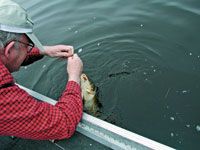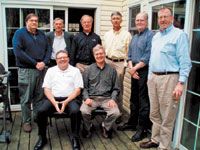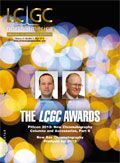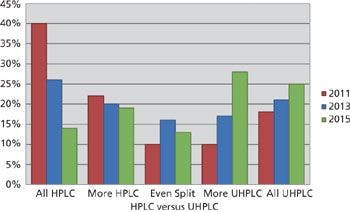The 2013 LCGC Awards
LCGC North America
Profiles of Peter W. Carr, the Lifetime Achievement in Chromatography award winner, and Davy Guillarme, the Emerging Leader in Chromatography winner
The results are in for the sixth annual LCGC Awards, and the winners continue to honor the legacy of chromatographers before them. The 2013 Lifetime Achievement in Chromatography Award is granted to Peter W. Carr, and the 2013 Emerging Leader in Chromatography Award is presented to Davy Guillarme. A complete listing of our prestigious award winners over the years is shown in Tables I and II.
Peter W. Carr
The Early Years
Summarizing or even touching on the vast accomplishments of a person like Peter W. Carr, whose career spans more than 50 years, is a daunting task, but let's start at the beginning. Carr majored in chemistry at the Polytechnic Institute of Brooklyn where he worked with Professor Louis Meites and graduated in 1965. During his undergraduate years, Carr actively pursued his career in the summer months. From 1961 to 1963 he was a laboratory technician at the American Molasses Company, and in 1965 he was a research assistant at Brookhaven National Laboratory, moving up to research associate in 1966. From there, he went on to get his PhD in chemistry under Professor Joseph Jordan at Pennsylvania State University followed by postdoctoral studies at Stanford University Medical School.

Peter W. Carr
Fellow Penn State graduate Richard A. Henry, formerly with Keystone Scientific and Penn State University, explained that Carr started his research in the field of electrochemistry and moved to calorimetry to prepare a thesis. His interest in separations didn't develop until after he received his PhD and started to pursue an academic career. Henry says we are all blessed that Carr chose to focus on separations. "The fields of electrochemistry and calorimetry did not need Pete Carr, but separations did," he said.

Table I: Winners of the LCGC Lifetime Achievement in Chromatography Award
Following his postdoctoral associate work at Stanford from 1968 to 1969, Carr accepted an assistant professor position in the chemistry department at the University of Georgia, where he was promoted to associate professor in 1975. In 1977, Carr moved to the University of Minnesota (UMN) as an associate professor in the department of chemistry. In 1981, he was made a full professor at UMN and he remains there to this day. During his tenure there, which spans more than three decades, Carr has held the titles Associate Director of the Cooperative Research Center for Bioanalytical Processing (1987–1990) and Associate Member with the Graduate Faculty for Microbial Engineering (1990–present).

Table II: Winners of the LCGC Emerging Leader in Chromatography Award
Major Scientific Contributions
Carr is well known for his pioneering contributions to the fundamental theory and practice of liquid chromatography (LC), with more than 400 highly cited papers and 18 patents under his belt. His early work focused on understanding retention and selectivity in reversed-phase LC, high performance liquid chromatography (HPLC), and gas chromatography (GC), including the development of various linear solvation energy relationships and the "hydrophobic subtraction model" of reversed-phase selectivity that is now in wide use. This work served as the inspiration for Ilja Siepmann, Carr's colleague at UMN, and Mark Schure to undertake more detailed computational modeling of retention in HPLC.

Figure 1: A collage of various group members, friends, and events from Carr’s career.
When we reached out to many of Carr's colleagues, past students, and friends — a group in which those labels are interchangeable — the resounding response to our question about Carr's biggest contributions to the field was, "Where does one start?" William E. Barber, an R&D manager for chemistries at Agilent Technologies and one of Carr's former PhD students, put it nicely: "Pete has contributed to and solved a wide variety of problems in separation science. He has been a critical contributor in the advancement of our understanding of the fundamental theory of HPLC, LC media, and stationary-phase development, and most recently, the areas of high-speed HPLC and two-dimensional [2D] LC."

Figure 2: Carr, an avid fisherman, is shown here landing a fish.
Victoria McGuffin, a chemistry professor at Michigan State University, shared Barber's feelings."One of Carr's strengths is that you can ask 10 separation scientists about his greatest contribution and get 10 different responses — all equally valid," she said. McGuffin cited Carr's work with detailed thermodynamic measurements and solvatochromic modeling of retention and selectivity among his most significant accomplishments. "These studies, together with their careful and thorough interpretation, have provided a clearer understanding of the role of the mobile and stationary phases in liquid chromatography as well as the relative contributions of polarizability and dipolarity, hydrogen-bond donor, and hydrogen-bond acceptor interactions," she said.

Figure 3: Carr taking in the beautiful scenery of St. Paul, Minnesota, during a fishing trip on the Mississippi River.
Lloyd Snyder, last year's LCGC Lifetime Achievement Award winner and a retiree from LC Resources, has known Carr since the early 1980s and coauthored some 20 papers with him. Snyder cited the importance of Carr's work with columns for use at extremes of pH and temperature, along with the development and commercialization of zirconia as an ultrastable support for HPLC, followed by hypercrosslinked and other phases to match. "These columns permitted the use of temperatures greater than 100 °C for improving the speed of analysis in HPLC, including application to reversed-phase, ion-exchange, and protein separations," said Snyder. "Pete is also the inventor of tandem thermally tuned HPLC, a really clever idea that allows a continuous variation of column selectivity during method development."
Dwight Stoll, an assistant professor at Gustavus Adolphus College, former graduate student of Carr's, and the 2011 winner of the LCGC Emerging Leader in Chromatography award, echoed Snyder's comments regarding Carr's work with zirconia. "Pete's work was important for the development of zirconia-based stationary phases for HPLC," Stoll said. "Since his work on this in the 1990s and 2000s, several other groups have picked up the work and several materials have been commercialized." One such commercialization was ZirChrom Separations, Inc., a company that Carr cofounded in 1995 with Clayton McNeff and Steven Rupp. Carr also served as the first president of the company.
Carr's most recent groundbreaking work is in ultrafast and 2D LC. "Pete's prior experience in both the thermodynamics and kinetics of HPLC has had a major impact on 2D-HPLC for the analyses of highly complex samples," said Snyder. "Two-dimensional separation is very demanding because it requires large values of N in the first dimension and fast separation (for example, <10 s) in the second dimension," he said. "The technology he has developed is also applicable to high-speed gradient elution."

Figure 4: A gathering prior to a recent MCF symposium. Standing (from left): Larry Potts, Don Hagen, Dick Henry, John Dolan, Pete Carr, and Bill Barber. Seated (from left): are Larry Bowers and Peter Johnson.
Barber feels this work is the highlight of Carr's career. "Pete seriously considered retiring several years ago but came to realize that the 2D LC project was in many ways the capstone of his career contributions in that it employed and integrated several of the contributions he had made earlier in his career, that is, theory, high-speed LC, and high stability media and stationary phases," he said.
Carr arguably has one of the world's leading and most active groups working in 2D separations, Stoll added.
Contributions to the Professional Community
Carr's contributions go beyond his own research, as he has been a very active member of the professional community. For instance, Carr cofounded the Minnesota Chromatography Forum (MCF) with Steve Anderson, Larry Bell, Larry Bowers, and Don Hagen in 1978 and became the first president of the group. "The MCF was born in the minds of a few Minnesota area chromatographers in early 1978," the organization's web site says (1). "It took final shape on St. Patrick's Day in 1978 over a pitcher of green beer. In 1979, a constitution was written and passed by the members, declaring the objectives of the MCF to be . . . to maintain and promote for education, discussion and exchange of information with respect to all fields of chromatography."
"All those present on St. Patrick's Day felt that there was a great need for education in chromatography that was not being met," said Larry Bowers of the United States Anti-Doping Agency and one of Carr's earliest PhD students. Bowers explained that the idea was to have quarterly meetings and an annual symposium at which chromatographers could learn from the experts and present their work on a local level. "The response from the community was overwhelming," Bowers said. The forum is active today, with three evening sessions held each year with invited speakers ranging from local experts to leading international chromatographers and an annual three-day spring symposium. The spring symposium continues to be a big success, bringing in about 250 attendees and 100 exhibitors annually.
In addition, Carr was chair of the Chromatography and Separations Chemistry Subdivision of the American Chemical Society's Division of Analytical Chemistry from 1987 to 1989 and the program chair of the International Symposium on Column Liquid Chromatography in 1994. Also, he has been an organizer of and presenter at many chromatographic sessions at the Pittsburgh Conference on Analytical Chemistry and Applied Spectroscopy (Pittcon) and the International Symposium on High-Performance Liquid-Phase Separations. Carr has also served on the editorial advisory boards of Analytical Chemistry, Talanta, Microchemical Journal, Journal of Chromatography, Chromatographia, Separation Science, and LCGC North America.
Carr's willingness to collaborate with other scientists also should not be overlooked. Bowers explained that Carr has an amazing ability to see the big picture and his education at an engineering school and work with Meites gave him the tools to integrate many disciplines into theoretical modeling. "He is very willing to share his knowledge and the credit for any product that arises," said Bowers.
Awards
As one might expect, someone with this many achievements is sure to receive accolades from the scientific community. Carr has received a long list of honors throughout his career. Some of his most notable awards are the L.S. Palmer Award from the Minnesota Chromatography Forum (1984); the Merit Award from the Chicago Chromatography Discussion Group (1987); the Benedetti-Pichler Award from the American Microchemical Society (1990); the Award in Analytical Chemistry from the Eastern Analytical Symposium (1993); the Dal Nogare Award of the Delaware Valley Chromatography Forum at Pittcon (1996); the ACS Award in Analytical Chemistry (2009); the A.J.P. Martin Gold Medal of the Chromatography Society (2010); and the Csaba Horvath Award of the Connecticut Separation Science Council and the Hungarian Chromatography Society (2010) — just to name a few.
Carr has also been the recipient of many honors for his teaching, including the Award for Outstanding Contributions to Postbaccalaureate, Graduate, and Professional Education from the University of Minnesota Alumni Association (2002). In the same year, he was entered into the Academy of Distinguished Teachers at UMN.
A Teacher's Legacy
As his teaching awards indicate, Carr has given the same level of dedication and intellect evidenced in his research to the numerous students he has taught. So far, Pete has mentored 14 MS students, 50 PhD students, and 36 postdoctoral associates. The results, notes McGuffin, are impressive. She explained that some of Carr's students have chosen academic careers at high-quality undergraduate institutions and leading research universities all around the word, while others have gone on to prominent industrial careers at small companies or even Fortune 500 companies. "The quality and breadth of his student's careers are a tribute to Professor Carr's dedication as a teacher and mentor," she concluded.
His students agree. "I think the aspect of Peter's professional work that is the most under-recognized is his extraordinary commitment to the personal and professional development of his graduate students," said Stoll. "Over the years, he has been incredibly loyal to them, supporting them well beyond their years in graduate school."
Stoll went on to explain that Carr spends a great deal of time providing advice to his former students on employment and professional decisions, often connecting them to one another professionally or introducing them to key people in the chromatography field. Stoll has taken Carr's mentorship to heart and practices his methods with his own students at Gustavus Adolphus College. "In this way, Peter's commitment to this aspect of his teaching has far reaching consequences beyond just the immediate generation of graduate students," he said.
Barber, another former student, mirrored Stoll's statements about Carr's teaching style. "The thing that impressed me the most about Pete as a thesis advisor was his dedication to his students," he said. "I always felt that he was not only willing to spend as much time as needed coaching his students but that he relished this time." Barber also discussed Carr's knack for knowing when to "let go" of his students, as some became independent researchers quickly, while others needed more coaching. "However, as soon as a student was ready to make the project his or her own, Pete was ready to let the student run with it," Barber said.
Barber also pointed out that Carr always asks his PhD students to investigate both a theoretical and practical aspect of their work. "The value of this, of course, is that it allows the student to contribute to the fundamental understanding of the science as well as producing something that is practically useful to others in the field," he said.
Personal Accounts
As Carr's students move on in their careers, he strives to maintain personal contact and friendships with them, as evidenced by the many stories shared with us for this article. Bowers is one example of that type of relationship: He was Carr's third PhD student and later became a long-time colleague at UMN.
And just as Carr formed lasting relationships with his students, he maintained strong connections with those that preceded him. Carr was very proud of the analytical chemistry history at UMN and visited with I.M. Kolthoff while he was still alive. "Despite his theoretical strengths, Pete's favorite saying was from Kolthoff: 'Theory guides, experiment decides,'" said Bowers. The analytical chemistry division softball team was even named "I.M. Kolthoff and You're Not."
In recent years, Carr became an avid fisherman and his love of the water was not lost on his students. Several photos included in this article are of Carr out fishing. Barber shared a story about picking Carr up on his 36-foot sailboat in the Chesapeake Bay just before the 2008 HPLC conference in Baltimore, Maryland. "Instead of driving, we sailed down the bay and up the Patapsco River into the Inner Harbor, where I docked the boat in a marina that was literally right next to the conference hotel," he said. "Pete got a real kick out of 'arriving' at the HPLC meeting under sail!"
Stoll also shared some personal stories of fishing trips spent with Carr, explaining that in the cases where conferences are held near a good fishing destination (such as Pittcon in New Orleans, Louisiana) Carr would often take a day to test the waters before or after the conference. Carr also has favorite spots near his home, such as the Mississippi River and Lake Vermillion. "As a graduate student I came to understand that an invitation to go fishing with Peter was not only a time to enjoy the beauty of the Mississippi River valley, but also a time to talk about new ideas for chromatography research and recount some of the rich history of the chromatography community," said Stoll. "These times spent with Peter are some of the experiences I treasure most."
Davy Guillarme
LCGC's 2013 Emerging Leader in Chromatography winner, Davy Guillarme, received his Masters degree in science in 2001 and his PhD in analytical science in 2004, both from the University of Lyon in France. His PhD thesis was focused on an evaluation and the use of high-temperature liquid chromatography. He completed his postdoctoral work in 2005 at the University of Geneva in Switzerland, where he researched the application of capillary electrophoresis coupled to mass spectrometry (MS) for the analysis of biological matrices. From 2006 to 2010 he was an "assistant master" at the University of Geneva, University of Lausanne, and in 2010 he was promoted to senior lecturer, a distinguished position for someone so young.

Davy Guillarme
Guillarme's research covers a wide range of areas in analytical science, including fast and high-resolution liquid chromatography using state-of-the-art approaches such as ultrahigh-pressure liquid chromatography (UHPLC), core–shell technology, high mobile phase temperature, and the use of silica-based monoliths; chromatography analysis of intact biomolecules including therapeutic peptides, proteins, and monoclonal antibodies (mAbs); hydrophilic interaction liquid chromatography (HILIC) for the analysis of polar and other ionizable compounds; the evaluation of supercritical fluid chromatography (SFC) using conventional and sub-2-µm particles; and LC–MS and UHPLC–MS applied to pharmaceutical analysis.
Guillarme's career has taken off at rocket speed, as his publications record attests. He has already published more than 77 peer-reviewed papers, and his recognition in the field (h-index = 23) is very high despite his young age.
"This is a very creditable record considering that his first publication in a major scientific journal was as recently as 2004," noted Professor David McCalley, a professor of bioanalytical science at the University of the West of England. "This means that this large number of publications has been produced within the space of only eight years."
Thus, Guillarme has been the author or coauthor of 10–12 publications per annum in the primary scientific literature during each of the past four years. In 2012, his work to date had received nearly 350 citations. "Two of these publications have well over 100 citations each, and thus can be classed as works of very significant impact," McCalley said.
Some key contributions include his work in fast and high-resolution chromatography, particularly comparing those approaches using various types of samples. He was one of the first scientists to publish on the extensive possibilities offered by UHPLC instruments. He also created a free Excel calculator that can determine the isocratic and gradient conditions to be used when transferring a method between HPLC and UHPLC; this tool has been downloaded more than 7000 times (2). Guillarme has also co-edited a book, UHPLC in Life Sciences, with colleague Jean-Luc Veuthey. Recently, Guillarme published a series of papers that discuss the possibilities of various modern wide-pore reversed-phase LC phases for the analysis of large biomolecules. The results of this latest work demonstrate that reversed-phase LC can be a useful approach for the characterization of intact proteins and mAbs.
Professor Gert Desmet, chair of the department of chemical engineering at the Free University in Brussels and the 2008 winner of the LCGC Emerging Leader in Chromatography award, pointed out that Guillarme is strong in both the theoretical and practical aspects of separation science, and also has a keen eye for topics of broad interest. "Starting from this interest, he always manages to make studies with a maximal impact," said Desmet.
Guillarme's major contributions to the field so far go beyond his published work; he has also been a key player at international meetings and conferences. To date, Guillarme has given 70 oral presentations and 87 posters at national and international scientific meetings.
McCalley gave high praise for the talks he has heard Guillarme present, such as one on the analysis of peptides and proteins with fused-core and UHPLC technologies at the HPLC conference in 2011. "Dr. Guillarme gave a comprehensive overview of his work in this rapidly developing area and its important principles, which was ideal for the practicing chromatographer," said McCalley. "His talks are very well structured and easy to follow, a talent which is somewhat rare amongst modern international conference speakers."
Michael W. Dong of Genentech was impressed with Guillarme's published works on high-resolution separations by UHPLC. So when he was looking for a fresh perspective and practical experience on the topic for a session he was organizing for Pittcon 2012, he invited Guillarme. "I was so impressed with him that he was invited back to speak again for Pittcon 2013," Dong said.
Dong and McCalley are not the only ones that have been impressed by Guillarme's work and presentation style, as evidenced by the fact that Guillarme has received several awards for such work in recent years. A few of those recognitions includes third prize for the Most Innovative Method Development Procedure given at the Conference on Small Molecule Science (CoSMoS) in 2012; first prize for the Best Poster Award given at the International Symposium on Chromatography (ISC '12) in 2012; and the Award for Excellence in Oral Presentation from Chimiometrie 2011.
Desmet has also been very impressed by Guillarme's speaking talents. "His natural charisma and excellent didactic skills allow him to clearly convey his message and enthusiasm to his audience," he said. "The field of chromatography will need people with this scarce talent more and more in the future."
Along with other colleagues, Guillarme has taken over some of the responsibility for the day-to-day running of the Analytical Pharmaceutical Chemistry Group at the University of Geneva. Professor Jean-Luc Veuthey remains the head of the group, but is presently also serving as one of the Vice-Chancellors of the university. McCalley noted that the work of this group is very well known. "The reputation of the group is enviable," he said "They have an emphasis on both the latest theoretical developments in separation science and their practical applications," he said. Guillarme makes good use of that combined theoretical and practical focus in his work educating and training practitioners through his lectures, conference talks, and web seminars (including some with LCGC).
Dong nicely summarized why Guillarme is deserving of our award. "His passion for separation science, productivity in chromatographic research, and growing influence are truly impressive at this early stage of his career," he said. "His chromatography acumen and drive to impact pharmaceutical analysis demonstrate that he is truly an emerging leader in chromatography."
More About the Winners
In-depth interviews with Peter W. Carr and Davy Guillarme, focused on their research, challenges, and accomplishments, will be published in upcoming editions of our newsletter, E-Separations Solutions.
References
(1) The Minnesota Chromatography Forum web site: www.minnchrom.com.
(2) Free HPLC calculator: http://www.unige.ch/sciences/pharm/fanal/lcap/telechargement-en.htm.
Meg Evans Managing Editor, LCGC North America and Spectroscopy Direct correspondence to:

New TRC Facility Accelerates Innovation and Delivery
April 25th 2025We’ve expanded our capabilities with a state-of-the-art, 200,000 sq ft TRC facility in Toronto, completed in 2024 and staffed by over 100 PhD- and MSc-level scientists. This investment enables the development of more innovative compounds, a broader catalogue and custom offering, and streamlined operations for faster delivery. • Our extensive range of over 100,000 high-quality research chemicals—including APIs, metabolites, and impurities in both native and stable isotope-labelled forms—provides essential tools for uncovering molecular disease mechanisms and exploring new opportunities for therapeutic intervention.
New Guide: Characterising Impurity Standards – What Defines “Good Enough?”
April 25th 2025Impurity reference standards (IRSs) are essential for accurately identifying and quantifying impurities in pharmaceutical development and manufacturing. Yet, with limited regulatory guidance on how much characterisation is truly required for different applications, selecting the right standard can be challenging. To help, LGC has developed a new interactive multimedia guide, packed with expert insights to support your decision-making and give you greater confidence when choosing the right IRS for your specific needs.

.png&w=3840&q=75)

.png&w=3840&q=75)



.png&w=3840&q=75)



.png&w=3840&q=75)











